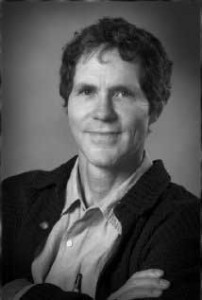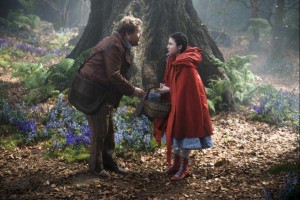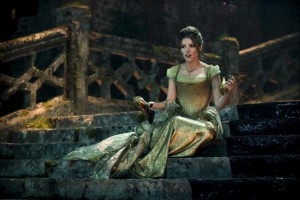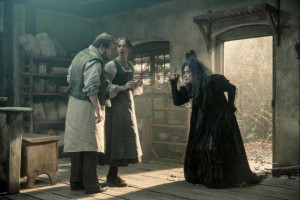
“Nature will inform you,” Dennis Gassner explained – citing one of the bedrock principles that guided his production design for the critically-lauded film adaptation of Stephen Sondheim’s musical, Into the Woods.
The story spins a kind of meta-fairy tale, where Cinderella, Jack and his beanstalk, Little Red Riding Hood and others, all find themselves in a single unified story, unfolding primarily in a single forest where they wander, fall, get lost and get found.
Gassner, who grew up in Oregon and worked as a lumberjack as a teenager, felt a special resonance to those woods when he came aboard the project. “We’ve cut down so many trees to build our world,” he observed, “and eventually, if we don’t take care of that world, it will just be the remaining trees that survive us.”
But Gassner, of course, had more than just a primal empathy for our forests to bring to the project. “I’m at a senior moment in my career,” he explained, “and it’s a nice time to reflect and look back.”
Such a rear-view mirror look takes in modern classics like Field of Dreams, a slew of Coen Bros. films from Miller’s Crossing to O Brother, Where Art Thou? and being the current successor to iconic James Bond designer Ken Adam, having overseen the last two Daniel Craig installments. Gassner was back on holiday break from the latest Bond film, Spectre, when he spoke to us about designing Into the Woods.

“You have to tell the story,” he said, “which is fairly simple. You have a village, a forest and a castle.”
That simplicity was part of what made this an “amazing project,” and a “great collaboration,” with director Rob Marshall, cinematographer Dion Beebe, costume designer Colleen Atwood and others.
Gassner’s first contribution to that collaboration came in the form of oak trees – specifically, the Angel Oaks. “You’re at a computer,” he recalled saying to Marshall, “Google it.”
The oaks are a form of Southern Live Oak, many of them hundreds of years old, and preserved in a park in South Carolina. The trees evoke the kind of bosky, moss-covered fecundity that one might have thought only remained in the mind’s eye, in an age of clearcutting.
But there they were, and Marshall found them as evocative as Gassner had. And while the actual Angel Oaks were never a location for the film, they were a touchstone, inspiring both locations and sets in the U.K., where the movie was shot.
 “We also looked at all the Grimm Brothers books,” he said, “as well as all of the illustrations” that had been done over the years, providing even more visuals that “kind of transcend everything – it’s magical.”
“We also looked at all the Grimm Brothers books,” he said, “as well as all of the illustrations” that had been done over the years, providing even more visuals that “kind of transcend everything – it’s magical.”
But magic aside, “How do you deal with space and the choreography of time within a forest?” Gassner asked. “It’s an unruly thing.”
So even though the goal was to evoke “nature in its purest form of storytelling,” there were elements on stage that had to be constructed, in order to frame the story’s structure.
But since this wasn’t a big-budget film” and Gassner noted he “couldn’t afford 25 sculptors” to make all those trees, he would need England to come through with its own evocative locations, especially when you put castles into the equation.
So he called up some friends on the other side of the pond, and “England came through.”
One of those locations was Windsor Park, with its own stately greens. Gassner explained that there weren’t a lot of visual effects in this film, in spite of the subject matter, so everything had to not only evoke that magic, but also be both real and practical.
 “The whole film was really handcrafted,” he said. Of course, “they’ve been doing it for centuries,” he says of English crews, harkening back to an age where Shakespeare and his peers first realized you could make a business out of charging admission for staged stories. All you needed to figure out, then, was how to recreate battles, make Arden forest live and witches seem real, in order to sell those stories – not so different from what the Bard’s cinematic heirs are doing now.
“The whole film was really handcrafted,” he said. Of course, “they’ve been doing it for centuries,” he says of English crews, harkening back to an age where Shakespeare and his peers first realized you could make a business out of charging admission for staged stories. All you needed to figure out, then, was how to recreate battles, make Arden forest live and witches seem real, in order to sell those stories – not so different from what the Bard’s cinematic heirs are doing now.
Gassner described his role as being the “first one on, and the first one off” a film, but he always “designs everything very specifically” before his own work is wrapped. “I leave a legacy there.”
In the case of Into the Woods, he got to see that legacy in a cut six months later – presumably while in the midst of figuring out how to follow up Spectre’s volcano-based rocket pads, from the ’60s – and thought, “That really worked out well.”
Gassner also mentioned that he’s been practicing yoga for 25 years, and he always opens that practice with “the standing posture, the tree posture. Through time, we’ve learned how to stand by watching the strength of what’s around us.”
As far as saving some of those trees, to keep imparting such strength (and inspirations for filmmakers), “We need to keep fighting the good fight,” he said, especially with a “young generation running through pixel world,” perhaps oblivious to what is still “real.”
Gassner, meanwhile, has a tree-lined journey of his own ahead, as Into the Woods makes its way through award season. Whether the work will yield a certain gold of its own, remains to be seen.





